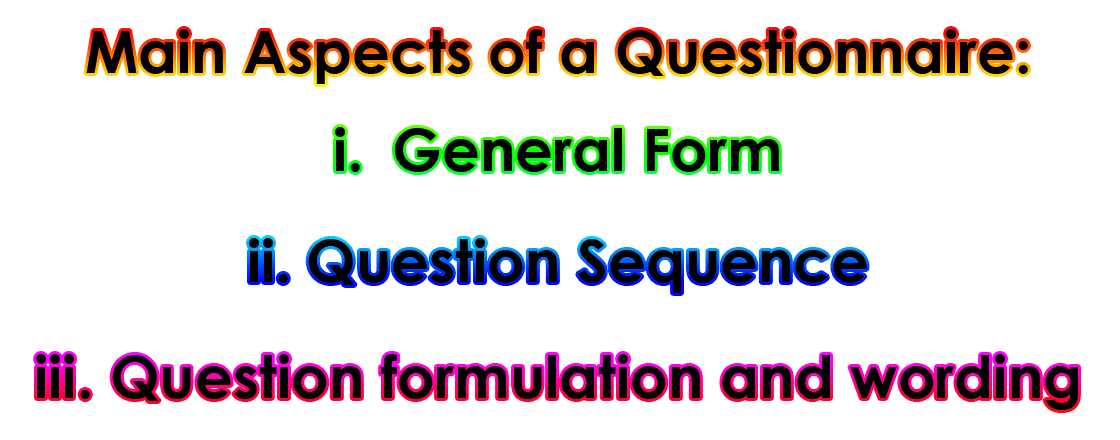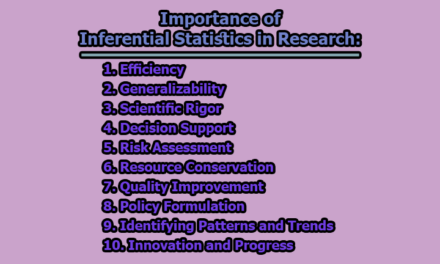Through the questionnaire method of data collection is quite popular, particularly in the case of big inquires. It is being adopted by private individuals, research workers, private and public organizations, and even by governments. A questionnaire consists of a number of questions printed or typed in a definite order a form or set of forms. The respondents have to answer the questions on their own.
Definition of Questionnaire:
“A questionnaire is a research instrument consisting of a series for the purpose of gathering information from respondents” (Wikipedia)
“A questionnaire is a list of a research or survey questions asked to respondents and designed to extract specific information” (Business Dictionary)
“A questionnaire is a structured form, either written or printed, consists of a formalized set of questions designed to collect information or some subject or subjects form one or more respondents” (Business Jargons)
Form the above definitions we can say that a questionnaire is a list of questions which basically consists of the demand of survey in specific fields.
Main Aspects of a Questionnaire:
Quite often questionnaire is considered as the heart of a survey operation. Hence it should be very carefully constructed. If it is not properly set up, then the survey is bound to fail. This fact requires us to a study the three main aspects of a questionnaire which are being;
i. General Form: So far as the general form of a questionnaire is concerned, it can either be structured or unstructured questionnaire. Structured questionnaires are those questionnaires in which there are definite and predetermined questions. The questions are presented with exactly the same wording and in the same order to all respondents. Reports is taken to this sort of standardization to ensure that all respondents reply to the same set of questions. Structured questionnaires may also be fixed alternative questions in which represents the informants that are limited to the stated alternatives.
Structured questionnaires are sample to administer and relatively inexpensive to analyze and unstructured questionnaires may be used effectively. Then on the basis of the results obtained pretest (testing before final use) operations from the use of unstructured questionnaires, one can construct a structured questionnaire for use in the main study.
ii. Question Sequence: In order to make the questionnaire effective and to ensure quickly to the replies received, a researcher should pay attention to the sequence of the questions in preparing the questionnaire. A proper sequence of questions reduces considerably the chances of individual questions being understood. The question-sequence must be clearly and smoothly-moving, meaning thereby that the relation of one question to another should be readily apparent to the respondent, with questions that are easiest to answer being put in the beginning. The first few questions are particularly important because they are likely to influence the attitude of the respondent and in seeking his desired co-operation. The opening questions should be such as to arouse human interest. The following type of questions should generally be avoided as opening questions in a questionnaire;
- Questions that put too great a strain on the memory or intellect of the respondent.
- Questions of a personal character.
- Questions related to personal wealth etc.
Following the opening questions, we should have questions that are really vital to the research problem and a connection thread should run through successive questions.
For instance, if one question deals with the price usually paid for coffee and the next with the reason for preferring that particular brand, the answer to this latter question may be couched largely in terms of price differences.
iii. Question formulation and wording: With regard to this aspect of the questionnaire, the researcher should note that each question must be very clear for any sort of misunderstanding can do irreparable harm to a survey. Questions should also be impartial in order not to give a biased picture of the true state of affairs. Questions should be constructive with a view to their forming a logical part of a well thought out tabulation plan. In general, all questions should meet the following standards;
- Should be easily understood.
- Should be simple i.e. should convey only one thought at a time.
- Should be con-create and should conform as much as possible to the respondent’s way of thinking.
Concerning the form of questions, we can talk about two principal forms, viz multiple-choice question and the open-end question.
Merits of the Questionnaire:
The merits claimed on behalf of this method are as follows;
- There is a low cast even when the universe is large and is widely spread geographically.
- It is free from the bias of the interviewer; answers are in respondents’ own words.
- Respondents have adequate time to give well thought out answers.
- Respondents, who are not easily approachable, can also be reached conveniently.
- Large samples can be made use of and thus the results can be made more deplorable and reliable.
Demerits of Questionnaire:
The main demerits of this system can be listed here;
- Low rate of return of the duly filled in questionnaires; bias due to no-response is often indeterminate.
- It can be used only when respondents are educated and cooperating.
- The control over the questionnaire may be lost once it is sent.
- There is the built-in flexibility.
- There is also the possibility of ambiguous replies.
- It is difficult to know whether willing respondents are truly representative.
- This method is likely to be the slowest of all.
At last, we can say that it is always advisable to conduct the survey for testing the questionnaires. In a big inquiry, the significance of the survey is felt very much to analyze the main theme of the information through the questionnaire.
References:
- Research Methodology Methods and Techniques by C.R. Kothari,
- Research Methodology-Sampling Design by Chinmay Rout.

Library Lecturer at Nurul Amin Degree College










